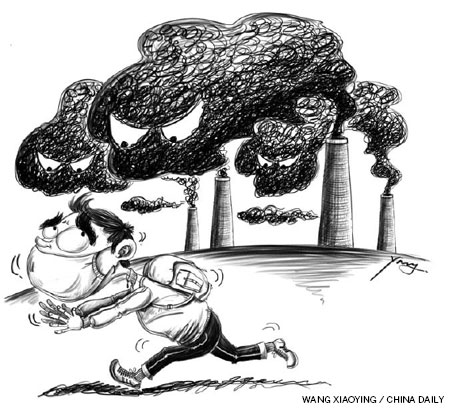Kids more vulnerable to environment

The recent high environmental pollution levels in Beijing and other Chinese cities should be seen as a great threat to children's health and quality of life. A large number of children die every year from environment-related diseases.
The good news is that we can prevent such deaths by using low-cost and sustainable tools and strategies to improve the environment.
A World Health Organization study shows that 13 million deaths across the world can be prevented just by improving the environment. In some countries, environmental change can rid governments of more than one-third of their burden, which is created by the spread of diseases.
The WHO study should help countries to choose appropriate intervention methods. According to the study, carried out in 23 countries, more than 10 percent of the deaths are caused by unsafe water (including poor sanitation and hygiene) and indoor air pollution, particularly from solid fuel used for cooking.
In the main Chinese cities, air pollution - caused by burning of highly polluting coal and noxious auto emissions - has become a major problem. One can imagine the extent of pollution in Beijing, where one in every four people owns a car. In fact, the Chinese capital has more than 5 million cars.
Children make up almost half the population of developing countries. And most of the deaths among children below 5 years of age can be attributed to intestinal and respiratory infections. This makes it important to not only address environmental factors, but also to use low-cost interventions such as immunization, better delivery and newborn care practices, and treatment of common infections to save children's lives.
It's not that environmental factors such as pollution, occupational diseases, radiation, and climate and ecosystem changes do not affect people in industrialized countries. The integrity of the global environment is being increasingly compromised by the deteriorating ozone layer and an ever-higher concentration of gases responsible for the greenhouse effect. The more severe these factors become the worse will be their impact on human health.
Environmental factors affect children's health from the time of conception and intra-uterine development through infancy and adolescence. Children are more vulnerable than adults to environmental factors because, among other reasons, their immune systems and detoxification mechanisms are not fully developed.
Intervention, both at the community and the national level, can significantly improve the environment by promoting water treatment and storage, and reducing air pollution. The last measure by itself could save almost 1 million lives a year.
Some measures taken at the local level are having a positive impact on the environment. In a South African city, for example, when conventional environmental health control measures to clean an overcrowded, unsanitary building housing several hundred people failed, a democratically elected tenants' committee initiated a series of measures to deal with the main problems and succeeded in its mission. The project has laid the foundation for dealing with environmental problems in city buildings in a participatory way.
In Cairo, Laila Iskandar Kamel has implemented innovative social and environmental projects while working with garbage collectors. The projects have helped garbage collectors break the cycle of exploitation and receive proper remuneration for their work. In addition, she has organized girls from the community to revive the most ancient of Egyptian crafts, weaving cloth on a handloom. The yarn for handloom comes from discarded cotton clothes, and she uses the profits for providing them better education and thus better livelihood.
In Qatar, the lack of natural resources, and climate change and air quality pose a serious challenge for the authorities. Among the measures taken by Qatari authorities to improve the environment is spreading environmental awareness among the people, particularly mothers. Besides, a new school curriculum emphasizes the importance of environmental issues.
In the Americas, eco-clubs are carrying out an outstanding series of environmental activities. The clubs are nongovernmental organizations, basically comprising children and adolescents who coordinate their activities through several community institutions.
Loja city in Ecuador used to be littered with dumping yards in thickly populated areas, which recently caused an outbreak of contagious diseases. Through an intensive sanitization and education campaign, in which community members played a key role, people built a sanitary landfill and started safe disposal of recyclable materials, leading to great improvement in the residents' lives.
Such projects are making children increasingly aware about the environment and their role in improving it. Planning, design, monitoring and management of the environment have become ideal platforms for children's participation. Such initiatives are taking place across the world with the aim of improving the environment and, as a result, people's health.
The Chinese government, therefore, has to increase its expenditure on environmental protection to ensure better health for people, especially children and elders, who are most vulnerable to environmental factors. The exercise may be expensive. But if it is not undertaken, the price China would have to pay in terms of children's lives will be much, much higher.
The author is an international public health consultant and author of Environmental Impact on Child Health.


















